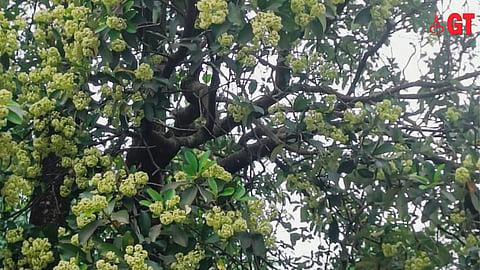

Asavari Kulkarni
The monsoon seems to be on the verge of biding adieu to the region. Walking down the wild paths under the bright blue sky, one notices the transition of the season while travelling along the roads of Goa. The plateau which was lush and green is now seen maturing with a display of yellow and brown shades. The tall grass seems foreboding to venture into, with the threat of unseen snakes and other wild critters.
Wildflowers are in bloom but not with the same exuberance as in the month of Shravan. Butterflies, vivid in their colouring, lay claim to the sweet nectar of an array of flowers. Hairy caterpillars crawl in nooks and corners. The damp, dull weather with its lashing rains is transformed into a cornucopia of vibrance and joy.
It is in the period of Sharad Ritu, or the autumn season, that the festival of creativity and regeneration Navratri is celebrated all over India. Though commonly called autumn, it is divided into three ritus in the Indian context. Sharad (mid-September to mid-November), Hemant (winter or mid-November to the beginning of January) and Shishir (January to the end of February). Sharad Ritu is actual a transition season between the monsoon and winter.
The flowering season for some plants like barleria (koranti), chrysanthemum (shevanti) and jasmine (kunda) begins with this transition. During late evenings, one may experience some mesmerising fragrance emanating from forests. Although a few people find this smell a little overpowering, others appreciate it and mistake it for the fragrance of Ratrani (night-blooming jasmine).
This enchanting fragrance radiates from the Saptaparni tree. It is called Saton in Konkani and the Devil’s tree in English. It is an attractive tree with whorls of leaves (usually seven, and hence the name Saptaparni), glabrous with a straight-growing trunk and a dull grey to whitish yellow colour. It is one of the fastest growing trees in the woods and may attain a height of up to 40 metres. The flowers are light green to creamy white in color and have an intoxicating, spicy scent. The pollen from this tree is known to aggravate bronchial problems like asthma.
The mature Saptaparni tree looks quite eerie, and, in the old days, people believed that ghosts resided in the tree, and one could become possessed by sleeping under the tree, hence the name Devil’s tree. One must personally experience hallucinating under the flower bloom of this tree. After standing below a fully-bloomed tree for more than 15 minutes, one may enter into a trancelike state.
The tree is native to China, South Asia and the Indian subcontinent. Its scientific name is Alstonia scholaris. “Alstonia” commemorates the distinguished botanist Charles Alston of Edinburgh, and the species name “scholaris” comes from the fact that the timber of the tree is used to make slates and blackboards. It belongs to the oleander or milkweed family (Apocynaceae/plants with milky sap).
Rarely do any species of animals reside or graze near the Saptaparni because the milky sap of the tree is considered toxic. Though the tree is considered toxic, Indian systems of medicine like Ayurveda and tribal folk medicine use this plant for chronic skin ulcers, dysentery, malaria and some stomach ailments.
On Narak Chaturdashi, or Diwali day, the bark of the tree, which is very bitter in taste, is consumed by the people of Pernem taluka in Goa. This tradition extends to the rest of the Konkan region too. The bark is brought home early in the morning, washed thoroughly and pounded in a mortar along with garlic, hing (asafoetida) and cumin seeds with a pinch of salt. It is believed to cleanse the digestive system and is a must during festivals as one tends to eat a lot of sweets.
Rabindranath Tagore’s fondness for the Saptaparni, which is also the state tree of West Bengal, is the reason why graduating students of the Vishwa Bharati University are presented a twig during the convocation.
The tree is planted as an avenue species since it is attractive with or without flowers. After fruiting, the tree looks like a willow tree and reminds one of the famous poem “The Willow-Tree” by William Makepeace Thackeray. In this autumn season, do experience the enchanting smell of these flowers during the full-moon, that is, Kojagiri Poornima, as it is called locally. I can assure you, you will have the most breathtaking experience of your life.